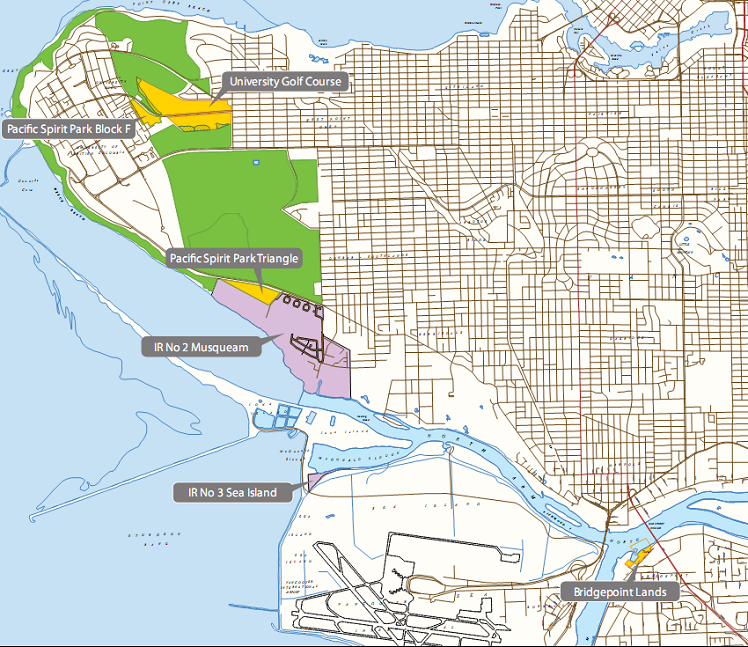This article was written by John Tompkins, and is reproduced with permission from the August 2012 edition of The Campus Resident, a newspaper published by the University Neighbourhoods Association.
It cannot be stopped; however, residents should “not be asleep at the switch” when it arrives.
Using graphic language from the world of railroads, leaders of the University Endowment Lands community sought to articulate their concerns about the coming development of a large tract of UEL forest by Musqueam First Nation at a meeting on July 16th.
While acknowledging the Musqueam development cannot be stopped, Michael Karton said, “I am concerned a runaway train is coming down the line at us.” Also while acknowledging the development cannot be stopped, Ellen Williams said, “There is a need for a forum for people to discuss this development—to get ready when it happens, so that we are not seen asleep at the switch.”
Both Mr. Karton and Ms. Williams sit on the UEL Community Advisory Council (CAC), and along with other CAC members, including chair Ron Pears, they debated vigorously the prospect of large-scale residential—and likely some commercial—development coming to 11 acres of forested and swampy UEL land between University Boulevard to the north, University Hill secondary school to the south, St. Anselm’s Anglican Church to the east and Acadia Road to the west.
The Musqueam band has owned the land since 2008 subject to a controversial agreement between the band and the provincial government, then led by Premier Gordon Campbell. “The 2008 Reconciliation Agreement between the Musqueam First Nation and the Province of British Colombia took the important step of transferring the Block F lands on University Boulevard to the Musqueam for their economic benefit,” UEL manager Marie Engelbert said in an e-mail.
CAC directors at their meeting in July referred repeatedly to an earlier meeting in which they had met with members of the Musqueam band. Ms. Williams said she got the impression at this earlier meeting the Musqueam planned a Block F community of 5,000 residents, but in a telephone conversation after the CAC meeting, Mr. Pears said the more likely Block F population would be 3,000.
Ms. Williams also said she got the impression the Musqueam were planning a 120-room high-rise hotel on the property. She called for significant public consultation about height and density on Block F. “We have got to get something—information—about into the public domain on this development,” she said.
A Musqueam source said the band plans to hold public open houses to seek the community views on the site with the first open house likely in September. In future meetings with the Musqueam, CAC members—on behalf of about 5,000 UEL residents—indicate they will seek more information about what zoning changes the Musqueam propose.
Ms. Engelbert said the reconciliation agreement, and the legislation that brought it into effect, provide “medium
density residential zoning for the Block F Lands, more specifically, the MF-1 (multi-family) zoning set out in the UEL bylaw, recognizing the economic development objectives of the Musqueam First Nation.”
She said the legislation “also provided for the possibility that circumstances might change allowing for the process of seeking a possible variation of this zoning, as other landowners can.” This means the Musqueam might look for housing density higher than is conveyed in the reconciliation agreement—certainly they won’t look for anything lower.
As a first step in responding to the prospect of the Block F ‘freight train’ tearing down the tracks toward the UEL community, the CAC agreed to form a Block F committee (or ‘working group’) at its September meeting. They also agreed on the need to call on consultants to assess Musqueam plans on their behalf once these plans are announced. “The consultants can become our heavy guns,” a director offered.
At the July CAC meeting, Ms. Engelbert, an employee of the ministry of community, sport and cultural development, asked CAC members to be fair in the way they approached this unprecedented UEL development in their area. “Don’t undermine the development process. It’s unfair to say the Musqueam haven’t been informative,” she said.
She also proposed the CAC “take what the Musqueam say at face value and work with them.”
“The Musqueam say they look for 100-year leases. They want it to be a respected development. They want to create good values,” she said.
In written response to a series of questions posed by the Campus Resident, Engelbert said, “The land (Block F) is currently zoned to allow for multi-family housing up to a height of 4 storeys or 45 feet.
“The developer has made no formal plans or proposals at this stage. Any proposal for development outside the existing multi-family zoning on the land will need to follow due process, which will incorporate a significant component of community consultation, at various stages in the process.
“As land owners, the Musqueam have a right to bring forward proposals for development of the land and for them to receive fair consideration; at the same time, the community has a right to have its voice heard.
“When the developer is in a position to move forward with some initial public consultation, the UEL Administration will work with them to ensure that full information about the process to be followed is available to the public.”
[Ed. For reference, the location of Block F is shown below.]







It is too bad that the Students no longer have an Armory from which to protect _their lands_.